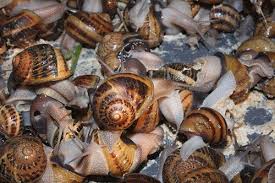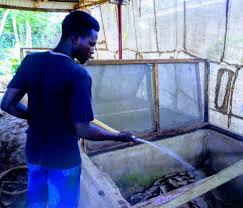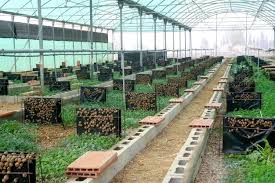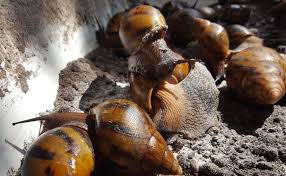Snail farming, also known as heliciculture, is an agricultural practice that has gained significant attention in recent years due to its potential as a sustainable source of protein and income. This practice involves the cultivation of snails for food, cosmetics, and medicinal purposes.
As the global population continues to grow, the demand for alternative protein sources increases, making snail farming an attractive option for farmers and entrepreneurs alike. Despite its advantages, snail farming faces several challenges that can hinder its growth and success.
One of the primary challenges in snail farming is the lack of awareness and understanding of the industry. Many potential farmers are unfamiliar with the intricacies of snail husbandry, including proper breeding techniques, feeding requirements, and disease management. This lack of knowledge can lead to poor farm management practices and, ultimately, low yields.
Furthermore, there is a need for more training programs and resources to educate new farmers about the best practices in snail farming, ensuring they are well-equipped to tackle common challenges.
Another significant challenge is the environmental conditions required for successful snail farming. Snails are sensitive to temperature and humidity, making it essential to create an optimal environment for their growth.
Extreme weather conditions, such as heavy rains or prolonged droughts, can negatively impact snail populations and, consequently, farm productivity. Farmers must invest in infrastructure to regulate temperature and humidity levels, which can be costly, particularly for small-scale farmers.
Moreover, disease and pest management pose additional challenges in snail farming. Snails are susceptible to various diseases, which can spread quickly within a farm and lead to significant losses.
Farmers must implement effective biosecurity measures to minimize the risk of disease outbreaks, which requires knowledge and resources. Pests, such as rodents and insects, can also threaten snail populations and must be managed effectively to ensure the farm’s success.
Despite these challenges, the potential of snail farming is immense. One of the most significant advantages is the rising demand for snails as a gourmet food item in various cultures worldwide. Snails are rich in protein, low in fat, and packed with essential nutrients, making them an attractive alternative to traditional livestock.
As consumers become more health-conscious and seek sustainable food sources, snail farming can play a crucial role in meeting this demand.
Additionally, snail farming can be an environmentally friendly agricultural practice. Snails require less land and water compared to conventional livestock, making them a more sustainable option.
They can be raised in various systems, including free-range, intensive, or semi-intensive setups, which allows for flexibility in farming practices. Moreover, snails can contribute to soil health through their droppings, which are rich in nutrients and can enhance soil fertility.
While snail farming presents various challenges, its potential as a sustainable agricultural practice cannot be overlooked. By addressing issues related to education, environmental conditions, and disease management, farmers can tap into the lucrative market for snails. With the right support and resources, snail farming can become a viable and profitable venture, providing nutritious food while promoting sustainable farming practices.
As interest in alternative protein sources continues to grow, the future of snail farming looks promising, paving the way for increased agricultural diversification and economic opportunities.
Benefits of Snail Farming

1. Low Capital Investment: Starting a snail farm requires relatively low capital compared to traditional livestock farming. Basic equipment and materials are needed, making it accessible for small-scale farmers.
2. High Market Demand: Snails are a delicacy in many cultures and have a growing market demand. They are rich in protein and low in fat, making them an attractive option for health-conscious consumers.
3. Eco-Friendly Farming: Snails are environmentally friendly as they require minimal resources and can be raised on small plots of land. They contribute to soil health by improving soil structure and nutrient content.
4. Quick Reproduction Rates: Snails reproduce quickly, with some species capable of laying hundreds of eggs at a time. This rapid reproduction can lead to quick returns on investment for farmers.
5. Nutritional Value: Snails are a good source of essential nutrients, including protein, vitamins, and minerals. This makes them a valuable addition to diets, particularly in regions with limited protein sources.
Common Challenges in Snail Farming
Despite the benefits, snail farming also comes with several challenges that farmers need to address:
1. Climate Sensitivity: Snails are sensitive to environmental conditions. Extreme temperatures or humidity levels can affect their growth and reproduction. Farmers must monitor and control the farming environment to ensure optimal conditions.
2. Predation and Pests: Snails are vulnerable to predators such as birds, rodents, and insects. Farmers need to implement measures to protect their snails from these threats.
3. Disease Management: Snails can be susceptible to various diseases and parasites. Effective health management practices are essential to prevent outbreaks that can devastate a farm.
4. Market Fluctuations: The market for snails can be unpredictable, with prices fluctuating based on supply and demand. Farmers must stay informed about market trends to make informed decisions.
5. Limited Knowledge and Resources: Many farmers may lack access to information and resources about snail farming techniques and best practices. Education and training are crucial for successful farming.
Read Also: Tangerine and Mandarin Stigma: Economic Importance, Uses and By-Products
Environmental Factors Affecting Snail Farming

Environmental factors play a significant role in the success of snail farming. Key factors include:
1. Temperature: Snails thrive in moderate temperatures. Extreme heat or cold can adversely affect their growth and reproductive rates. Ideal temperatures range from 20°C to 25°C (68°F to 77°F).
2. Humidity: Snails require high humidity levels (around 70-90%) for optimal growth. Low humidity can lead to dehydration and stress, while excessive moisture can cause diseases.
3. Soil Quality: The quality of the soil used in snail farming impacts their growth and health. Well-drained, nutrient-rich soil is essential for healthy snail development.
4. Water Availability: Snails need access to clean water for hydration and maintaining moisture levels in their environment. Insufficient water can hinder their growth and reproductive success.
5. Shelter and Space: Snails need adequate shelter to protect themselves from predators and extreme weather. Providing sufficient space for movement and growth is essential for their well-being.
Health and Disease Management in Snails
Effective health and disease management is crucial for a successful snail farm. Key practices include:
1. Regular Monitoring: Farmers should regularly monitor their snails for signs of illness or stress. Early detection of health issues can prevent the spread of disease.
2. Hygiene Practices: Maintaining cleanliness in the snail farming environment is essential to prevent disease outbreaks. Regularly cleaning feeding areas and removing waste can help reduce the risk of infections.
3. Quarantine Measures: New snails introduced to the farm should be quarantined for a period to prevent the introduction of diseases. This allows farmers to observe their health before mixing them with existing stock.
4. Veterinary Support: Consulting with veterinarians or aquaculture specialists can provide valuable insights into managing snail health. They can offer guidance on disease prevention and treatment options.
5. Nutrition and Stress Reduction: Proper nutrition and minimizing stressors (such as overcrowding or extreme environmental changes) can enhance snail immunity and reduce the likelihood of disease outbreaks.
Snail Nutrition and Feeding Practices
Proper nutrition is essential for the growth and productivity of snails. Key aspects of snail nutrition include:
1. Balanced Diet: Snails require a balanced diet that includes calcium, protein, and various vitamins and minerals. Common feed sources include vegetables, fruits, and commercial snail pellets.
2. Calcium Sources: Calcium is crucial for snail shell development. Providing calcium-rich foods like crushed eggshells or limestone can help ensure strong shell formation.
3. Feeding Frequency: Snails should be fed regularly, typically every 2-3 days. Farmers should monitor food intake and adjust feeding quantities based on the snails’ growth stage.
4. Clean Water Supply: Access to clean water is essential for snails. Water helps with digestion and hydration. Farmers should ensure fresh water is always available.
5. Avoiding Toxic Foods: Certain plants and substances can be toxic to snails. Farmers must avoid feeding snails any harmful plants and ensure that their feed is free from pesticides or chemicals.
Read Also: List of Diseases Ruminant Animals (Livestock) Get from Feeds and Water
Housing and Infrastructure Requirements

Proper housing and infrastructure are critical for successful snail farming. Here are some essential considerations:
1. Snail Housing Types: Snails can be raised in various housing structures, including:
i. Greenhouses: Provide controlled environments, protecting snails from harsh weather conditions while maintaining humidity levels.
ii. Land-Based Pens: Outdoor pens can be established with proper fencing to protect snails from predators while allowing natural grazing.
iii. Indoor Rearing Systems: Suitable for commercial-scale farming, offering complete control over temperature and humidity.
2. Space Requirements: Each snail requires enough space to grow and thrive. A general guideline is about 1 square meter (approximately 10.76 square feet) for every 40 to 60 snails. Overcrowding can lead to stress and hinder growth.
3. Environmental Control: Snail housing should facilitate environmental management, including:
i. Ventilation: Ensure proper airflow to regulate humidity levels and prevent the buildup of harmful gases.
ii. Temperature Control: Housing should maintain moderate temperatures, ideally between 20°C and 25°C (68°F and 77°F), to support optimal growth.
4. Moisture Retention: Snails require high humidity levels (around 70-90%). The housing should include materials that retain moisture, such as wet straw or leaves, and a system for misting or watering the environment.
5. Infrastructure for Feeding and Watering: Design feeding stations and water troughs to prevent contamination and ensure easy access. Regular cleaning is essential to maintain hygiene and prevent disease.
Breeding and Reproduction Techniques
Understanding effective breeding and reproduction techniques is vital for snail farming success. Here are key practices:
1. Selection of Breeding Stock: Choose healthy and high-quality snails for breeding. Look for species known for their reproductive efficiency, such as the African giant snail (Achatina fulica) or the European brown snail (Helix aspersa).
2. Mating Behavior: Snails are hermaphroditic, meaning they possess both male and female reproductive organs. Allow ample space for snails to engage in mating behaviors, which typically occur in moist conditions.
3. Egg-Laying Conditions: After mating, snails lay eggs in soft, moist soil or substrate. Provide suitable nesting sites with sufficient moisture and temperature for successful egg development.
4. Incubation Period: Snail eggs generally require 2 to 4 weeks to hatch, depending on environmental conditions. Maintain appropriate humidity and temperature during this period to ensure a high hatch rate.
5. Juvenile Care: Once hatched, juvenile snails (hatchlings) require special care. Provide them with adequate food, moisture, and shelter. Monitor their growth closely to ensure healthy development.
Pest and Predator Control in Snail Farming
Pests and predators pose significant threats to snail farming. Here are effective control measures:
1. Physical Barriers: Construct barriers around snail housing to prevent access by predators such as birds, rodents, and other animals. Fencing or mesh can help protect the farm.
2. Natural Predators: Utilize natural predators to control pest populations. For example, introduce beneficial insects that feed on harmful pests without harming the snails.
3. Environmental Management: Maintain cleanliness around the snail farm to minimize pest habitats. Regularly remove debris, weeds, and organic matter that could attract pests.
4. Chemical Controls: If necessary, use chemical pest control methods cautiously, ensuring they are safe for snails. Always follow recommended guidelines to avoid harming the snail population.
5. Monitoring and Inspection: Regularly inspect the snail housing and surrounding areas for signs of pests or predators. Early detection allows for prompt intervention.
Economic Considerations in Snail Farming
Understanding the economic aspects of snail farming is crucial for profitability. Key considerations include:
1. Initial Investment: Calculate the startup costs, including housing, breeding stock, feeding, and infrastructure. A clear financial plan helps ensure a sustainable operation.
2. Operational Costs: Monitor ongoing expenses, such as food, water, maintenance, and labor. Efficient management can help reduce costs and increase profitability.
3. Market Prices: Stay informed about market trends and prices for snails. Understanding demand can help determine the right time to sell and maximize profits.
4. Profitability Potential: Analyze potential profits based on production capacity, costs, and market prices. Snail farming can be lucrative if managed effectively.
5. Diversification Opportunities: Consider diversifying by incorporating value-added products, such as snail slime for cosmetics or processed snail meat. This can enhance income potential.
Regulatory and Legal Challenges
Navigating regulatory and legal challenges is essential for successful snail farming. Here are key considerations:
1. Licensing and Permits: Research local regulations regarding snail farming. Obtain necessary licenses or permits to operate legally and ensure compliance with agricultural laws.
2. Animal Welfare Standards: Adhere to animal welfare standards and best practices to ensure the health and well-being of snails. This may include proper housing, feeding, and care requirements.
3. Food Safety Regulations: Comply with food safety regulations if selling snails for consumption. Ensure safe handling and processing practices to meet health standards.
4. Environmental Regulations: Understand local environmental regulations related to land use and waste management. This includes ensuring sustainable practices that minimize environmental impact.
5. Record Keeping: Maintain accurate records of breeding, feeding, and financial transactions. Proper documentation can help demonstrate compliance with regulations and provide valuable insights for farm management.
.Do you have any questions, suggestions, or contributions? If so, please feel free to use the comment box below to share your thoughts. We also encourage you to kindly share this information with others who might benefit from it. Since we can’t reach everyone at once, we truly appreciate your help in spreading the word. Thank you so much for your support and for sharing!






